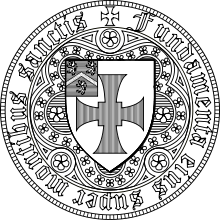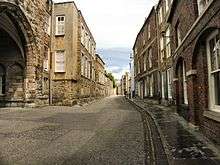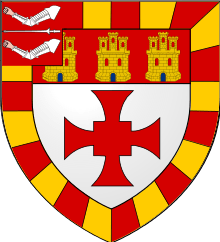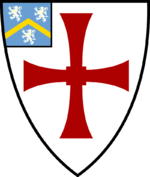Colleges of Durham University

The Colleges of Durham University are residential colleges which are the primary source of accommodation and support services for undergraduates and postgraduates at Durham University, as well as providing bursaries and scholarships to students. They also provide funding and/or accommodation for some of the research posts in the University. All students at the University are required to be members of one of the colleges.
Durham University has 16 colleges, of which University College is the oldest, founded in 1832. The newest college is Josephine Butler, founded in 2006. The last single sex college, St Mary's, became mixed in 2005 with the admittance of male undergraduates. One college, Ustinov, admits only postgraduates.
Colleges

Durham operates a collegiate structure similar to that of the University of Oxford and the University of Cambridge, in that all the colleges at Durham are "listed bodies"[1] under the Education Reform Act, 1988, "recognised by the UK authorities as being able to offer courses leading to a degree of a recognised body" (the "recognised body" being, in this case, the federal University). Though most of the Durham colleges are governed and owned directly by the University itself, and so do not enjoy the independence of colleges at Oxford and Cambridge, the status of the Durham colleges is similar to those in Oxford and Cambridge, setting Durham colleges apart from those at the universities of Kent, Lancaster, and York. However, unlike at Oxford and Cambridge (and federal universities such as London and the University of the Highlands and Islands, there is no formal teaching at most Durham colleges (although St John's and St Chad's have their own academic and research staff and offer college-based programmes in conjunction with the University). The colleges dominate the residential, social, sporting, and pastoral functions within the university, and there is heavy student involvement in their operation.

Formal dinners (known as "formals") are held at many colleges; gowns are often worn to these events. There is a great deal of intercollegiate rivalry, particularly in rowing and other sporting activities. There is also rivalry between the older colleges of the Bailey and the newer colleges of the Hill.
Types of college
The University is collegiate in structure. There are four different sorts of college: Maintained Colleges and Societies, Recognised Colleges, Licensed Halls of Residence, and Affiliated Colleges.
- Maintained Colleges are governed directly by, and are financially dependent on, the University. Their principals and staff are appointed by University Council. The maintained colleges are overseen by the Deputy Warden, who is also a member of the University Executive Committee.
- Recognised Colleges (St John's and St Chad's) are 'recognised' as colleges of the University, but they are actually incorporated as separate institutions. They are in effect accredited, being governed, financed and managed independently of the University and being educational charities in their own right. However, as a condition of their ongoing recognition by the University, the University's Council must approve the appointment of their principals and be notified of changes to their constitutions.[2]
- Licensed Halls of Residences are, unlike Recognised Colleges, not recognised as colleges of the University, and their principals are only ex officio members of Senate if the hall has 25 or more matriculated students in residence. Under statute 14, Council may recognise any college within County Durham as a licensed hall of residence; at the moment only Ushaw College is recognised in this statute, Neville's Cross College (now merged into New College Durham) was a licensed hall from 1924 to 1977.[3] The regulations as to the approval of principals and changes to their constitutions apply to licensed halls in the same way as to recognised colleges
 St John's College, one of the two independent colleges
St John's College, one of the two independent colleges - Affiliated Colleges are treated under statue 39, rather than statutes 14 & 15 like the other colleges. This states that Council may, on the recommendation of Senate, recognised any college as an affiliated college. There are currently no affiliated colleges. Previous affiliated colleges have included Codrington College in Barbados, Fourah Bay College in Sierra Leone (now part of the University of Sierra Leone), and Sunderland Technical College (now the University of Sunderland).[4] Affiliated colleges are not generally considered part of the collegiate structure of the University.
The University validates degrees at other colleges not recognised under any of the above categories. Current arrangements include the validation of the Church of England's Common Award at a number of theological colleges.[5] The Royal Academy of Dance also used to teach courses leading to degrees validated by Durham.
List of colleges
Most of the colleges located in Durham itself can be grouped into two areas of the city. Bailey colleges are those located on the peninsula formed by a meander of the River Wear, and Hill colleges are on Elvet Hill on the other side of the river. Queen's Campus, Stockton, is 23 miles (37 km) south of Durham, in the town of Stockton-on-Tees.
The student numbers in the table below are up to date for the 2010/11 year.
U = Undergraduates, P = Postgraduates, F = Female, M = Male
| Shield | College | Campus | Founded | U[6] | P[6] | P/U Ratio | % F[6] | % M[6] | Total[6] | Website | Notes |
|---|---|---|---|---|---|---|---|---|---|---|---|
| Collingwood | Durham (Hill) | 1972 | 1006 | 40 | 0.04 | 47% | 53% | 1046 | |||
| Grey | Durham (Hill) | 1959 | 762 | 49 | 0.06 | 50% | 50% | 811 | |||
| Hatfield | Durham (Bailey) | 1846 | 679 | 134 | 0.20 | 50% | 50% | 813 | |||
| Josephine Butler | Durham (Hill) | 2006 | 728 | 137 | 0.19 | 55% | 45% | 865 | |||
| St Aidan's | Durham (Hill) | 1947 | 784 | 204 | 0.26 | 43% | 57% | 988 | |||
| St Chad's | Durham (Bailey) | 1904 | 351 | 107 | 0.30 | 55% | 45% | 458 | Recognised College | ||
| St Cuthbert's Society | Durham (Bailey) | 1888 | 1046 | 89 | 0.09 | 51% | 49% | 1135 | |||
| St Hild & St Bede | Durham | 1975 | 1027 | 206 | 0.20 | 52% | 48% | 1233 | Merger of the College of the Venerable Bede (founded 1838) and St Hild's College (founded 1858) | ||
| |
St John's | Durham (Bailey) | 1909 | 347 | 72 | 0.21 | 53% | 47% | 419 | Recognised College | |
| St Mary's | Durham (Hill) | 1899 | 677 | 68 | 0.10 | 55% | 45% | 745 | |||
| Trevelyan | Durham (Hill) | 1966 | 610 | 54 | 0.09 | 53% | 47% | 664 | |||
| University | Durham (Bailey) | 1832 | 611 | 115 | 0.19 | 52% | 48% | 726 | |||
| Ustinov | Durham (Hill) | 1965 | 0 | 1582 | – | 51% | 49% | 1582 | Postgraduate-only, Founded as the Graduate Society | ||
| Van Mildert | Durham (Hill) | 1965 | 879 | 81 | 0.09 | 50% | 50% | 960 | |||
| Stephenson | Queen's | 2001 | 927 | 6 | 0.01 | 54% | 46% | 933 | |||
| John Snow | Queen's | 2001 | 800 | 16 | 0.02 | 60% | 40% | 816 | |||
| Durham University | 11234 | 2963 | 0.26 | 52% | 48% | 14197 | |||||
Heads of Colleges
The senior member of each college is an officer known generically as the Head of College.[7] His or her specific title varies from college to college as indicated in the list below, but there is no particular significance to the variation. The heads of the maintained colleges are also part-time members of an academic department.
- Principal: Collingwood College, John Snow College, Josephine Butler College, St Aidan's College, St Chad's College†, St Cuthbert's Society, College of St Hild and St Bede, St John's College, St Mary's College, Stephenson College, Trevelyan College, Ustinov College, Van Mildert College
- Master: Grey College, Hatfield College, University College
- †The Principal of St Chad's is also officially known as 'President' (as was the head of Ushaw College). The titual head of that college is known as the 'Rector'. Similarly, the Chair of the St John's College Council is the 'President' of that College.
Former Colleges
A number of colleges have been part of Durham University but have since folded or cancelled their association with the university.
Durham University currently recognises sixteen colleges. However, since its foundation in 1832, a number of other colleges have been part of the university. Two of these have become completely defunct; others have ended their association with the university, or left to become independent institutions of their own.
Bishop Cosin's Hall
Cosin's Hall on Palace Green was opened as the university's third college in 1851. However, a collapse in Student numbers in the late 1850s and 1860s meant the university was unable to sustain three colleges at the time, and it was merged into University College in 1864.[8] University College maintained offices and rooms in the Hall until 2006. The building (which was also the original home of University College before it moved into the castle) is still owned by the university and has been used by the Institute of Advanced Study since January 2007.[9]
Former Principals of Bishop Cosin's Hall
Neville's Cross College
Neville's Cross College was opened in 1921. It was primarily a teacher-training college; but from 1924 it was also a licensed hall of the University and admitted students to read for both undergraduate courses and postgraduate degrees. The College merged with Durham Technical College in 1977 to form New College Durham, whereupon it ceased to be associated with the University.[3]
Ushaw College

Ushaw College was a Catholic seminary located in Ushaw Moor, a village to the west of Durham. It was opened in 1808 by scholars who had fled from Douai, France, when English College was forced to close during the French Revolution. It affiliated with Durham as 'Licensed Hall' in 1968, though it retained its role primarily as a seminary. It shut as a seminary in 2011 due to a declining number of vocations in the Catholic Church, but remains recognised as a licensed hall in the University's statutes. Part of the college is now used by Durham Business School,[11] and it is also used for conferences and lectures by the Department of Theology and Religion.[12][13]
Colleges in Newcastle

In 1852, the School of Medicine and Surgery (founded in 1834) in Newcastle upon Tyne was absorbed into the University of Durham as the College of Medicine, allowing students to study for the Licence in Medicine in Durham, after which students could practise Medicine and take the degrees of Bachelor and Doctor in Medicine.[14] At the same time, Neville Hall was opened in Newcastle 'for the reception of Students in Medicine'.[15] The Hall closed at the end of the academic year in 1855/56. In 1871, the College of Medicine was joined by the College of Physical Science, later renamed Armstrong College.[16]

Relations between the two campuses were often strained. They became two autonomous parts of the same university, with the Newcastle colleges merging to become King's College in 1937.[14] In 1947 a proposal to rename the university as the "University of Durham and Newcastle" was approved by all the governing bodies, but was defeated at convocation by 135 votes to 129 in the spring of 1952.[17][18] This defeat led to King's College eventually leaving the university, to create the new University of Newcastle upon Tyne in 1963.[16]
| Development of the Newcastle Colleges of Durham University | ||||
|---|---|---|---|---|
| School of Medicine and Surgery 1834 |
Newcastle upon Tyne College of Medicine,
in connection with the University of Durham |
Durham University College of Medicine 1870 |
King's College 1937 - 1963 | |
| College of Physical Science 1871 |
Durham College of Science 1883 |
Armstrong College 1904 | ||
Presidents of the College of Medicine
|
Principals of the College of Science
|
Rectors of King's College
- 1937-1951 Lord Eustace Percy[26]
- 1951-1963 Charles Bosanquet (first Vice-Chancellor of Newcastle University)[26]
Sunderland Technical College
Sunderland Technical College was affiliated to Durham from 1930 to 1963 in the Faculty of Applied Science, and was thus associated with the Newcastle division of the University. When the Newcastle division became Newcastle University in 1963, Sunderland's affiliation with Durham ended. In 1969 the Technical College merged with Sunderland Teacher Training College and the Sunderland School of Art to form Sunderland Polytechnic (now the University of Sunderland).[27][28]
University College Stockton
Originally established in 1992 as the Joint University College On Teesside (JUCOT), a limited company established as a joint venture between Durham and the University of Teesside operating under the name of University College Stockton, this became a teaching and residential college of Durham in 1994 as University College Stockton (UCS), the JUCOT company being wound up. In 1998 the teaching and residential aspects were separated, with teaching becoming the responsibility of the University of Durham, Stockton Campus. In 2001 UCS was replaced by two new colleges, Stephenson and John Snow.[29][30]
Principals of University College Stockton
- 1992 – 1994 Robert Parfitt
- 1994 – 2001 John Hayward
Colleges abroad
Durham University has had two affiliated colleges outside England. Of these, Fourah Bay College is a former part of the university, having ended its affiliation in 1967. It became a constituent college of the University of Sierra Leone on that date.[31] The other affiliate, Codrington College, remained listed as an affiliated college until removed in the revision of the University's statutes approved by the Queen in Council on 13 July 2011.[32]
Renamed and merged colleges
The College of St Hild and St Bede was formed from the merger of two separate colleges in 1975. The College of the Venerable Bede (usually known as Bede College) had been an all male college formed in 1838, with St Hild's College formed as an all female college in 1858. The merged College continued as a recognised college until 1979, when it was taken over by the University and became a maintained college. Prior to this, the two colleges had specialised in the teaching of education;[33] on becoming a maintained college the teaching part of Hild Bede was separated from the College to become the University's School of Education.
The Graduate Society became a full college in 2003 and was subsequently renamed Ustinov College. The Home Students Association (for non-collegiate women) became St Aidan's Society in 1947 and subsequently St Aidan's College in 1961. Hatfield College was originally established as Bishop Hatfield's Hall, taking on its current name in 1919. St Mary's College was founded as the Women's Hostel, becoming a college and taking its current name in 1920.
Stephenson College (originally George Stephenson College) and John Snow College were created in 2001. They replaced the original University College Stockton and are located on the Queen's Campus at Stockton-on-Tees.[34]
Fictitious colleges
Jesus College and Coverdale Hall are the settings for the events in Angels and Men, Durham alumna Catherine Fox's first novel (published by Hamish Hamilton in 1996). The location is nowhere stated explicitly, but it is obvious to anyone familiar with the city and the university that it takes place in Durham; Jesus and Coverdale are modelled (very closely) on St John's College and Cranmer Hall.
That Hideous Strength (1943) by C. S. Lewis is set in a fictional university town, whose resemblance to Durham is close enough to require Lewis to insist in the book's preface that it is not so.[35]
See also
- Colleges of the University of Cambridge
- Colleges of the University of Oxford
- Colleges of the University of York
References
- ↑ Recognised UK Degrees
- ↑ The approval of principals generally means that short-lists of potential principals are agreed with the university ahead of time (1) to safeguard the independence of the 'recognised' colleges and to avoid a situation where a college's preferences differ from the university's, and (2) officially to confer ex officio membership of Senate onto the principals of the recognised colleges.
- 1 2 "Durham University Records: Colleges". Durham University Library Special Collections Catalogue. Neville's Cross College. Retrieved 8 March 2016.
- ↑ "Introduction - University of Sunderland". Saatchi Gallery. Retrieved 8 March 2016.
- ↑ "Partnership with Durham University". Church of England. Retrieved 7 March 2016.
- 1 2 3 4 5 "College Statistics". Durham University.
- ↑ "General Regulations". Durham University. I – Definitions. Retrieved 11 March 2016.
(k) "Head of College" means the Master or Principal of a maintained College, a recognised College, or a Licensed Hall of Residence.
- ↑ Whiting, C.E. (1932). The University of Durham. London: Sheldon Press.
- ↑ The Institute of Advanced Study Durham University, Accessed December 2006
- 1 2 3 4 5 6 7 8 9 10 11 12 "Durham University: Earlier Foundations and Present Colleges, Fowler, Joseph Thomas (1904)" (PDF). Kessinger Publishing. Retrieved 2009-02-25.
- ↑ "Getting Here". Durham University Business School. 15 January 2016. Retrieved 11 March 2015.
- ↑ "Past Events 'Early Modern Catholics in the British Isles and Europe: Integration or Separation?'". Department of Theology and Religion. Durham University. Retrieved 11 March 2016.
- ↑ "Ushaw Lectures Series". Department of Theology and Religion. Durham University. Retrieved 11 March 2016.
- 1 2 Foundation of the University Durham University, Accessed December 2006
- ↑ Durham University Calendar for 1856. Durham University. 1856. p. 147.
- 1 2 History Archived December 10, 2007, at the Wayback Machine. Newcastle University, Accessed December 2006
- ↑ "History of the Society". Durham University Society. University's name not changed. Archived from the original on 6 February 2005.
- ↑ Bettenson, E.M. (1971). The University of Newcastle upon Tyne 1834-1971. Newcastle: Hindson & Andrew Reid Ltd.
- ↑ "SIR DAVID DRUMMOND, M.D., D.C.L". The British Medical Journal. 1 (3722): 865–6. 1932. doi:10.1136/bmj.1.3722.865. PMC 2520934
 . PMID 20776837.
. PMID 20776837. - ↑ "Sir D. Drummond Resigns the Presidency". Sunderland Daily Echo and Shipping Gazette. 30 October 1926. Retrieved 12 March 2016 – via British Newspaper Archive. (subscription required (help)).
- ↑ "Thomas (Sir) Oliver". Lives of the Fellows. Royal College of Physicians. Retrieved 12 March 2016.
- ↑ "Robert Alfred (Sir) Bolam". Lives of the Fellows. Royal College of Physicians. Retrieved 12 March 2016.
- 1 2 "So Thats Why Its Called!". Newcastle University.
- ↑ "Hadow Manuscripts". Sheffield University.
- ↑ "Your Paintings". BBC.
- 1 2 "Durham University Records: Central Administration and Officers". Durham University Archives. Vice-Chancellor and Warden. Retrieved 11 March 2016.
- ↑ George Louis Payne (1960). Britain's Scientific and Technological Manpower. Stanford University Press. p. 201.
- ↑ "University of Newcastle upon Tyne Academic Board". Newcastle University. 19 May 2004. Retrieved 12 March 2016.
Alumni of Durham with Sunderland matriculation were entitled to be part of this University’s Convocation as, at the time of the creation of the University of Newcastle upon Tyne, the Technical College in Sunderland was, by the Statutes in force for the federal University, an affiliated college of the University of Durham in the Faculty of Applied Science – which was based in the Newcastle Division. The Statutes stated that any change to those Statutes must be ‘without prejudice to the rights of any students who are members of the University’ at the time the change was made. As students from Sunderland Technical College were entitled to be members of the Convocation of the federal University it would have prejudiced them if they were not allowed to be members of the Convocation of the new University of Newcastle upon Tyne since they were in the same position as those students in Statute 42 (2) – ie those who had been registered students of the Newcastle Division of the University of Durham before the appointed day’;
- ↑ John Hayward (2003). Breaking the Mould: The Surprising Story of Stockton (PDF).
- ↑ "Foundation of Queen's Campus". Archived from the original on 16 October 2004.
- ↑ "University Calendar Part I, General Regulation XII, Affiliation of Codrington College, Barbados, to the University." (PDF). (11.2 KiB). Retrieved 7 October 2007
- ↑ "Statutes of the University of Durham" (PDF). 13 July 2011. Retrieved 7 March 2016.
- ↑ History of College College of St Hild and St Bede, Accessed December 2006
- ↑ "Dialogue: Stephenson College". Durham University. 2008-10-20. Retrieved 2010-08-15.
- ↑ "That Hideous Strength (Space Trilogy, Book 3)". Retrieved 2009-02-15.
External links
- Durham University: Colleges
- Some Residential Colleges of the University of Durham
- Pasta with a side order of philosophy, please
